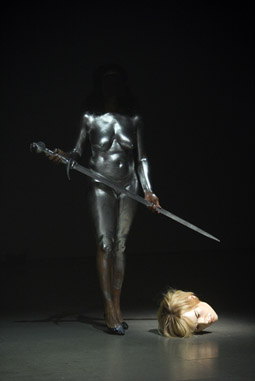 |
Sonia Beltran Napoles, Hey Girl!, Socìetas Raffaelo Sanzio photo Peter Manninger |
From the dripping slime to the silver, armour-like paint the white girl later slathers onto the black girl, Romeo Castellucci’s Hey Girl! is full of visual surprises and tensely sculpted stage space. Hey Girl! plunges us viscerally into women’s oppression, racial subjugation, betrayal and splintered willpower, using a few narrative fragments and a multitude of visuals, some illustrative, some opaque.
The best moments are both illustrative and opaque. For example, there are two oversized fake heads in the performance, both sculpted to look like the white girl. The heads appear close in time. After the white girl is beaten, she reappears from the line of now-still men wearing the artificial head and waving a huge black flag. She begs for the lights to go off. When the lights return, the head lies ‘decapitated,’ stage front: one of the many “queens who lost their head on account of the people” that the girl listed earlier on. For a moment, the head is simply illustrative.
Then there is female sobbing. The white girl walks gently through the crowd of men and brings forward the source of the cries: a black woman wearing an even larger version of the artificial head. So much for simplicity. When the white woman sees a version of her own face on another woman’s body, it’s a moment of total identification; it is also a moment where identification is cut. The white girl falsely comforts, apologizes, and beheads the white face from the black body. Then, although ashamed of herself, she joins in enslaving – or is she releasing – the black woman. There is similarity, there is difference; there is a shift of power from the white woman being a victim to the white woman victimizing; there is also a long list of words – all nouns – being projected above their heads. The interaction between the girls is so codified, and non-naturalistic, that any communication between them invites but resists interpretation.
Tension can be generated by presenting a highly codified scene and then asking the audience to decode with little assistance. This tactic flourishes in performance art, a genre that asks viewers to watch body-based action in a context made difficult either by long duration, physical discomfort or extreme content. Thinking about performance art helps me translate Hey Girl! because it specifically resonated with my experience of Marina Abramovic’s Lips of Thomas (1975, 2005). Naked, Abramovic alternates through a group of gestures aimed at exhausting her body so it can escape the heavy codes of Christianity and communism (Abramovic grew up in the former Yugoslavia and continues to use the name Yugoslavia for her homeland). She eats honey, whips herself on the back, lies on a cross of ice until numb, cuts a star into her belly, stands at attention in a pair of military boots and listens to a folk song, eats honey again. Because the actions and the timeframe are both extreme – the 2005 performance extended the original work from less than an hour to eight hours – the analytical mind can’t process what’s going on until later. If authority pushes the bodies it manipulates to total exhaustion, then authority collapses from the lack of having something to control.
Hey Girl! similarly works to shatter symbols by presenting bodies and structures on the edge of physical damage and exhaustion. Bodies on stage are in pain, at least if they’re female. The girls are buried, shackled, beaten, traded, but also capable of wielding a sword or joylessly dancing. Viewers’ bodies are affected: the viscous pink material is palpably revolting; we endure the acrid smells of lipstick, perfume and fabric burned against a flagrantly phallic hot metal sword. When at last the patriarchal, colonial gaze, represented quite literally by four suspended lenses that hang between the white girl and the shackled black girl, snaps, only then can a new code be written, though it initially involves dancing around the shattered glass left from the previous hierarchies.
Hey Girl! is theatre, though, not performance art. It’s theatre that asks us to move into an understanding with our gut more than with our mind. Canadian actor and writer Darren O’Donnell once said, “What theatre is really about – like any other form – is generating affect, and that’s it. Feelings. And, if things go well, quickly following feelings will be thoughts. Stories certainly can do this, but they’re not the only thing to do it, and they’re no longer always the best way to do it” (Social Acupuncture, 2006). Castellucci aims at our affect directly. As Hey Girl! evolves, visuals that seem iconic become messy and harsh moments are tempered by sudden kindnesses. This complexity means that, afterwards, images continue to shift and morph, playing with the mind and maybe never yielding a stable response. It’s an effective way to go into culturally familiar stories about women surviving violence because it provokes authentic feelings around gender and race.
Socìetas Raffaelo Sanzio, Hey Girl!, director, design, lights, costumes Romeo Castellucci, performers Silvia Costa, Sonia Beltran Napoles, original music Scott Gibbons, statics and dynamics Stephan Duve, lighting technique Giacomo Gorini, Luciano Trebbi, sculptures Plastikart, Istvan Zimmerman; Frederic Wood Theatre, University of British Columbia, Jan 23-26; PuSh International Festival of Performing Arts, Jan 16-Feb 3
Meg Walker is a nomadic fiction and non-fiction writer currently based in Vancouver, where she also spends plenty of time making visual art.
© Meg Walker; for permission to reproduce apply to [email protected]








 back
back